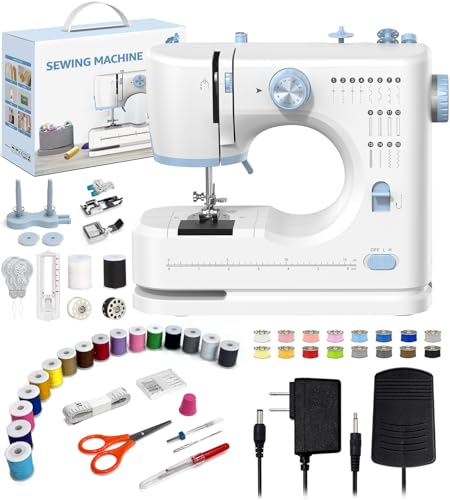If you’re an avid sewer, you know how essential it is to have a dedicated space for your sewing machine. Putting your sewing machine in a cabinet not only saves space but also keeps your sewing area organized and tidy. Plus, it can add a touch of elegance to your crafting corner.
Understanding the Basics of Sewing Machine Cabinets
Choosing the right sewing machine cabinet is crucial for maximizing your sewing experience and keeping your workspace organized.
Types of Sewing Machine Cabinets
Various types of sewing machine cabinets are available, catering to different needs and preferences:
- Compact Cabinets: Ideal for small spaces, these cabinets can be folded away when not in use. Some models, like the Sauder Sewing Craft Cart, offer extra storage while being space-efficient.
- Full-Sized Cabinets: These provide ample workspace and storage. Typically, they come with multiple drawers, shelves, and a larger surface area, making them perfect for extensive projects.
- Portable Cabinets: Equipped with wheels, these can be easily moved around. They often have collapsible extensions for additional workspace.
- Custom Cabinets: Tailor-made to your specifications, these cabinets are designed to match your sewing habits and room aesthetics perfectly.
Benefits of Using a Sewing Machine in a Cabinet
Utilizing a sewing machine cabinet offers several advantages:
- Organization: Cabinets keep your sewing supplies neatly stored, including bobbins, needles, and fabrics.
- Space Efficiency: A cabinet ensures that your sewing machine has a dedicated spot, freeing up other areas in your room.
- Convenience: With built-in storage and an organized layout, you spend less time searching for tools and more time sewing.
- Aesthetics: Cabinets add a touch of elegance to your crafting space, making it inviting and inspiring.
- Protection: Cabinets protect your sewing machine from dust and accidental damage, ensuring it remains in good working condition.
Understanding these basics enables you to choose the best sewing machine cabinet that meets your needs and enhances your sewing experience.
Preparing to Install Your Sewing Machine
Organizing your sewing space around a cabinet can boost efficiency. Before installation, ensure you have the right tools and measurements.
Gathering Necessary Tools and Materials
Collecting all needed tools and materials ensures smooth installation. Gather your sewing machine manual, cabinet manual, screwdriver set, measuring tape, mounting brackets, screws, and a drill. Having these materials on hand streamlines the process and reduces interruptions.
Measuring Your Sewing Machine and Cabinet Space
Accurate measurements are crucial for fitting your sewing machine into the cabinet. Measure the width, height, and depth of your sewing machine. Note these values. Then, measure the cabinet’s inner space. Confirm that the machine dimensions match the cabinet’s capacity. If the measurements align, you can proceed with the installation confidently.
Step-by-Step Guide to Installing a Sewing Machine in a Cabinet
Efficiently installing a sewing machine in a cabinet can elevate your sewing experience. Follow these steps to secure your machine and optimize its usability.
Securing the Sewing Machine to the Cabinet
Ensure your machine is securely attached to avoid movement during use. Begin by positioning your sewing machine in the cabinet’s designated space. Use the bolts and screws provided with the cabinet to lock the machine in place. Tighten the bolts with a wrench for stability. Check the machine’s alignment in the cabinet, and adjust if necessary, before fully tightening the screws.
Managing Cables and Connectors
Organize the cables to keep your workspace clutter-free. First, locate the power cord and foot pedal cable. Use cable clips or ties to gather excess length. Route the cables through any pre-installed holes or slots in the cabinet to prevent tangling. Ensure connectors are accessible but out of your sewing path to avoid disruption. Test all functions before proceeding.
Adjusting the Sewing Machine for Optimal Use
Fine-tune the machine’s position for comfortable operation. Adjust the height of the sewing platform within the cabinet to match your ergonomics. The needle area should be at elbow height when you sit. Use adjustable features like an elevating platform to customize the height. Lastly, confirm the sewing machine is level to avoid uneven stitching.
By following these steps, you can confidently install your sewing machine in a cabinet, enhancing your crafting efficiency and enjoyment.
Maintenance Tips for Your Sewing Machine Cabinet
Maintaining your sewing machine cabinet ensures you maximize its lifespan and keep your sewing area tidy. Follow these practical tips to care for your sewing machine cabinet effectively.

Regular Cleaning and Dusting
Clean your sewing machine cabinet periodically to keep it looking its best. Use a microfiber cloth to wipe down all surfaces every week. Remove any fabric lint or thread, as these can accumulate and affect the functionality. Use a vacuum with a brush attachment to clean hard-to-reach areas.
Checking and Tightening Loose Components
Regularly inspect your sewing machine cabinet for any loose screws or hinges. Tighten any loose parts with a screwdriver to prevent mishaps. Focus on the hinges, drawer handles, and any moving parts to ensure smooth operation. If a part looks worn or damaged, replace it to avoid further issues.
Conclusion
Having a designated space for your sewing machine can truly transform your sewing experience. A sewing machine cabinet not only saves space but also keeps your supplies organized and your machine protected. By choosing the right cabinet and following the installation steps, you can create a convenient and aesthetically pleasing sewing area. Remember to maintain your cabinet with regular cleaning and check-ups to ensure it stays in top condition. Happy sewing!






![KPCB Tech Sewing Machine for Beginners [Full Set] with Finger](https://m.media-amazon.com/images/I/41I3AiyNlWL._SL500_.jpg)










